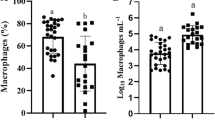Abstract
The opsonic components of breast milk responsible for phagocytosis of surface-adherentStaphylococcus aureus by human polymorphonuclear leukocytes were investigated. There was significantly greater phagocytosis of bacteria pre-opsonized with 100 % breast milk than of unopsonized bacteria (p<0.001). Heat inactivation of breast milk had no effect on surface phagocytosis, indicating that phagocytosis is independent of complement. The predominant immunoglobulin in breast milk, secretory immunoglobulin A (IgA), did not promote phagocytosis. In contrast, IgG, which is present in very low amounts in breast milk (0.05 mg/ml), was as opsonic as 100 % breast milk, suggesting that this is the major opsonin. An oxidative burst as measured by chemiluminescence was observed during phagocytosis of bacteria pre-opsonized with 100 % breast milk. Heat inactivation of breast milk reduced the chemiluminescence response to the level of control. Neither secretory IgA nor IgG stimulated a polymorphonuclear leukocyte chemiluminescence response to surface-adherent bacteria. These experiments indicate that IgG is the principal component of breast milk responsible for surface phagocytosis but that complement is required for the generation of chemiluminescence and thus may be essential for intracellular killing of bacteria. Secretory IgA, despite its abundance in breast milk, has no effect on surface phagocytosis or neutrophil chemiluminescence.
Similar content being viewed by others
References
Robinson JE, Harvey BA, Soothill JF Phagocytosis and killing of bacteria and yeast by human milk cells after opsonization in the aqueous phase of milk. British Medical Journal 1978, 1: 1443–1445.
Mata LJ, Wyatt RG Host resistance to infection. American Journal of Clinical Nutrition 1971, 24: 976–978.
Nakajima S, Baba AS, Tamura N Complement system in human colostrum. International Archives of Allergy and Applied Immunology 1977, 54: 428–433.
Reddy V, Bhaskaram C, Raghuramulu N, Jagadeesan V Antimicrobial factors in human milk. Acta Paediatrica 1977, 66: 229–232.
Jagadeesan V, Reddy V C3 in human milk. Acta Paediatrica Scandinavica 1978, 67: 237–238.
Goldman AS, Garza C, Nichols BL, Goldblum RM Immunologic factors in human milk during the first year of lactation. Journal of Paediatrics 1982, 100: 563–567.
Wilson ID Studies on the opsonic activity of human secretory IgA using an in vitro phagocytosis system. Journal of Immunology 1972, 108: 726–730.
Lee DA, Hoidal JR, Clawson CC, Quie PG, Peterson PK Phagocytosis by PMN ofStaphylococcus aureus andPseudomonas aeruginosa adherent to plastic, agar or glass. Journal of Immunological Methods 1983, 63: 103–114.
Vandenbroucke-Grauls CMJE, Thijssen HMWM, Verhoef J Interaction between human polymorphonuclear leukocytes andStaphylococcus aureus in the presence and absence of opsonins. Immunology 1984, 52: 427–435.
Gordon DL, Rice JL Opsonin-dependent and independent surface phagocytosis ofS. aureus proceeds independently of complement and complement receptors. Immunology 1988, 64: 709–714.
Gordon DL, Avery VM, Rice JL, McDonald PJ Surface phagocytosis ofStaphylococcus epidermidis andEscherichia coli by human neutrophils: serum requirement for opsonization and chemiluminescence. FEMS Microbiology Immunology 1989, 47: 417–424.
Cripps AW, Neoh SH, Smart IJ Isolation of human IgA and IgM from normal serum using polyethylene glycol precipitation and affinity chromatography. Journal of Immunological Methods 1983, 57: 197–204
Laemmli UK Cleavage of structural proteins during the assembly of the head of bacteriophage T4. Nature 1970, 227: 680–685.
Gordon DL, Rice JL, Avery VM Surface phagocytosis and host defense in the peritoneal cavity during continuous ambulatory peritoneal dialysis. European Journal of Clinical Microbiology and Infectious Diseases 1990, 9: 191–197.
Lee DA, Hoidal JR, Garlich DJ, Clawson CC, Quie PG, Peterson PK Opsonin-independent phagocytosis of surface adherent bacteria by human alveolar macrophages. Journal of Leukocyte Biology 1984, 36: 689–701.
Verhoef J, Peterson PK, Quie PG Kinetics of staphylococcal opsonization, attachment, ingestion and killing by human polymorphonuclear leukocytes: a quantitative assay using [3H]-thymidine labelled bacteria. Journal of Immunological Methods 1977, 14: 303–311.
Fanger MW, Shen L, Pugh J, Bernier GM Subpopulations of human peripheral granulocytes and monocytes express receptors for IgA. Proceedings of the National Academy of Sciences of the USA 1980, 77: 3640–3644.
Fanger MW, Pugh J, Bernier GM The specificity of receptors for IgA on human peripheral polymorphonuclear cells and monocytes. Cellular Immunology 1981, 60: 324–334.
Walsh GM, Kay AB Binding of immunoglobulin classes and subclasses to human neutrophils and eosinophils. Clinical and Experimental Immunology 1986, 63: 466–472.
Quie PG, Messner RP, Williams RC Phagocytosis in subacute bacterial endocarditis. Localization of the primary opsonic site to Fc fragment. Journal of Experimental Medicine 1968, 128: 553–570.
Zipursky A, Brown EJ, Bienenstock J Lack of opsonization potential of 11S human secretory A1 (36983). Proceedings of the Society of Experimental Biology and Medicine 1973, 142: 181–184.
Gorter A, Hiemstra PS, Leijh PCJ, van Der Sluvs ME, van Der Barselaar MT, van Es LA, Daha MR IgA-and secretory IgA-opsonizedS. aureus induce a respiratory burst and phagocytosis by polymorphonuclear leukocytes. Immunology 1987, 61: 303–309.
Gorter A, Hiemstra PS, Leijh PCJ, Leijh LA, Daha MR Stimulation of human polymorphonuclear leukocytes by serum IgA or secretory IgA. Advanced Experimental Medicine and Biology 1987, 216B: 1325–1331.
Fanger MW, Goldstine SM, Shen L Cytofluorographic analysis of receptors for IgA on human polymorphonuclear cells and monocytes and the correlation of receptor expression with phagocytosis. Molecular Immunology 1983, 20: 1019–1027.
Weisbart RH, Kacena A, Schuh A, Golde DW GM-CSF induces human neutrophil IgA-mediated phagocytosis by IgA Fc receptor activation mechanisms. Nature 1988, 332: 647–648.
Kassim OO, Afolabi O, Ako-nai KA, Torimiro SEA, Littleton AK, Mboglia CN, Oke O, Turner W, Grissom F Immunoprotective factors in breast milk and sera of mother-infant pairs. Tropical and Geographical Medicine 1986, 38: 362–366.
Author information
Authors and Affiliations
Rights and permissions
About this article
Cite this article
Avery, V.M., Gordon, D.L. Antibacterial properties of breast milk: Requirements for surface phagocytosis and chemiluminescence. Eur. J. Clin. Microbiol. Infect. Dis. 10, 1034–1039 (1991). https://doi.org/10.1007/BF01984925
Issue Date:
DOI: https://doi.org/10.1007/BF01984925



